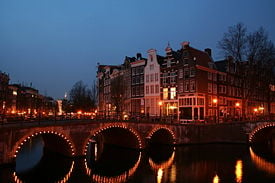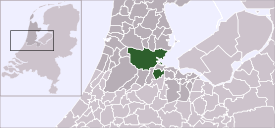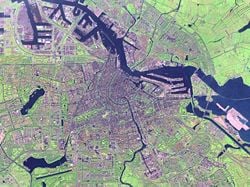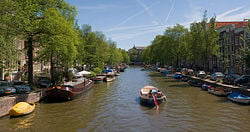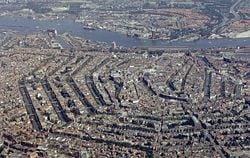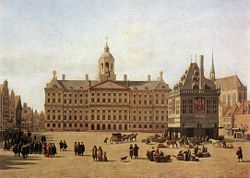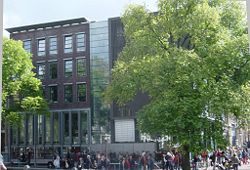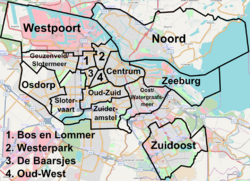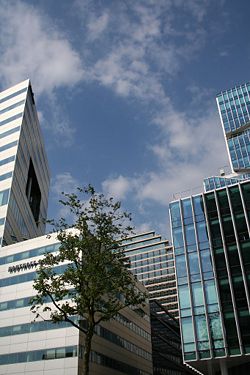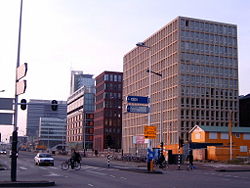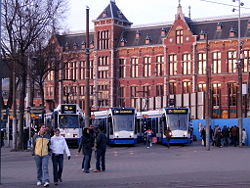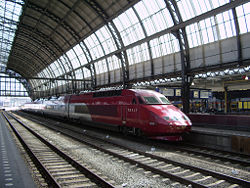Amsterdam
| Amsterdam | |||
| The Keizersgracht at night | |||
|
|||
| Nickname: Mokum | |||
| Motto: Heldhaftig, Vastberaden, Barmhartig (Valiant, Determined, Compassionate) |
|||
| Location of Amsterdam | |||
| Coordinates: {{#invoke:Coordinates|coord}}{{#coordinates:52|22|23|N|4|53|32|E|type:city | |||
|---|---|---|---|
| name= }} | |||
| Country | Netherlands | ||
| Province | North Holland | ||
| Government | |||
| - Mayor | Job Cohen (PvdA) | ||
| - Aldermen | Lodewijk Asscher Carolien Gehrels Tjeerd Herrema Maarten van Poelgeest Marijke Vos |
||
| - Secretary | Erik Gerritsen | ||
| Area [1][2] | |||
| - City | 219 km² (84.6 sq mi) | ||
| - Land | 166 km² (64.1 sq mi) | ||
| - Water | 53 km² (20.5 sq mi) | ||
| - Urban | 896 km² (345.9 sq mi) | ||
| - Metro | 1,896 km² (732 sq mi) | ||
| Population (January 1, 2006)[2][3] | |||
| - City | 743,027 | ||
| - Density | 4,459/km² (11,548.8/sq mi) | ||
| - Urban | 1,209,419 | ||
| - Metro | 2,191,259 | ||
| - Randstad | 6,659,300 | ||
| Time zone | CET (UTC+1) | ||
| - Summer (DST) | CEST (UTC+2) | ||
| Website: www.amsterdam.nl | |||
Amsterdam ▶ is the capital city of the Netherlands, located in the south of the province North Holland. The city was founded in the late 12th century as a small fishing village at the mouth of the river Amstel. The historical centre with its concentric canals was largely built during the Dutch Golden Age in the 17th century. Amsterdam has more then 7500 protected monuments. Amsterdam has the largest historical citycentre from Europe.
Geography
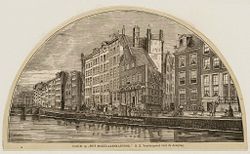
The name Amsterdam literally means Amstel dam. The city of Amsterdam is located on the banks of the rivers Amstel and Schinkel, and the bay IJ. Several parts of the city and of the urban area are polders, recognisable by their postfix -meer meaning 'lake', such as Aalsmeer, Bijlmermeer, Haarlemmermeer, and Watergraafsmeer.
Amsterdam enjoys a moderate temperate climate, with the weather patterns being strongly influenced by Amsterdam's proximity to the North Sea to the west and its prevailing north-western winds and gales. Winter temperatures are mild, reaching 32.9°F (.5°C) in January. Frosts occur during spells of easternly or northeasternly winds blowing in from the inner European continent, i. e. from Scandinavia, Russia and even Siberia.
Summers are warm but rarely hot, reaching 70.5°F (21.4°C) in July. Amsterdam averages less than 760mm of precipitation annually. Most of it falls as protracted drizzle or light rain. cloudy and damp days common, particularly in cooler months, October through March.
The inner city is divided by its network of canals into some 90 “islands,” and the municipality has approximately 1300 bridges and viaducts. The Amsterdam canal system is the result of conscious city planning. In the early 17th century—when immigration was at a height—a comprehensive plan was developed that was based on four concentric half-circles of canals with their ends resting on the IJ bay. Known as the Grachtengordel, three of the canals are mostly for residential development: Those are the Herengracht (Gentleman's Canal), Keizersgracht (Emperor's Canal), and Prinsengracht (Prince's Canal’). The fourth and most outer canal, the Singelgracht (not to be confused with the Single), served purposes of defense and water management. The defensive purpose was established by moat and earthen dikes, with gates at transit points, but otherwise no masonry superstructures. Furthermore, the plan envisaged: (1) Interconnecting canals along radii; (2) creating a set of parallel canals in the Jordaan quarter, primarily for transportation purposes; (3) converting the defensive purpose of the Single—an already existing inner perimeter canal—to a residential and commercial purpose; (4) constructing more than one hundred bridges.[citation needed]
Construction started in 1613 and proceeded from west to east, across the breadth of the lay–out, like a gigantic windshield wiper as the historian Geert Mak calls it—and not from the centre outwards as a popular myth has it. The canal constructions in the southern sector were accomplished by 1656. Subsequently, the construction of residential buildings commenced slowly. The eastern part of the concentric canal plan, covering the area between the Amstel river and the IJ bay, has never been implemented. In the following centuries, the land was used for parks, old people homes, theaters, other public facilities, and waterways without much planning.
Over the years, several canals have been filled up becoming streets or squares, such as the Nieuwezijds Voorburgwal and the Spui.
The urban area includes the municipalities: Aalsmeer, Amsterdam, Amstelveen, Diemen, Haarlemmermeer, Ouder-Amstel, Uithoorn, and Waterland. The size of the urban area (land only) was 277.2 square miles (718.03 km²).
The metropolitan area consists of the urban area, its satellite cities, and the intervening rural land that is socio-economically connected to Amsterdam. This includes the municipalities: Aalsmeer, Almere, Amsterdam, Amstelveen, Beverwijk, Blaricum, Bloemendaal, Bussum, Castricum, Diemen, Haarlem, Haarlemmerliede, Haarlemmermeer, Heemstede, Heemskerk, Hilversum, Huizen, Laren, Muiden, Naarden, Oostzaan, Ouder-Amstel, Purmerend, Uitgeest, Uithoorn, Velsen, Waterland, Weesp, Wijdemeren, Wormerland, and Zaanstad. The total size of the metropolitan area (land only) was 558.8 square miles (1,447.36 km²).
History
Amsterdam began as a fishing village in the late 12th century. The damming of the river Amstel gave it its name (in Dutch: Amstelredam "Dam in the Amstel", turned into Amsterdam in the course of time). The traditional founding of the city of Amsterdam is October 27, 1275, when the inhabitants living around the Amstel dam were granted freedom from paying the tolls associated with the locks and bridges of Holland. It was given city rights in 1300 or 1301.
From the 14th century on, Amsterdam flourished, largely on the basis of trade with the cities of the Hanseatic League. In 1345 a Eucharistic miracle occurred near the Kalverstraat and Amsterdam would remain an important pilgrimage city until the Alteration to the protestant faith; today the Stille Omgang - a silent procession in civil dress - remains of the rich pilgrimage history.
In the 16th century, the Dutch rebelled against Philip II of Spain and his successors. The revolt escalated into the Eighty Years' War which ultimately led to Dutch independence and the imposition of Protestant Calvinism as de facto state religion. In 1578 the previously Catholic city of Amsterdam joined the revolt and all churches were confiscated for the reformed Protestant worship.
After the break with Spain, the Dutch Republic became known for its relative religious tolerance, except towards Catholics who had to worship secretly. Jews from Spain and Portugal, prosperous merchants from Antwerp (economic and religious refugees from the part of the Low Countries still controlled by Spain), and Huguenots from France (persecuted for their religion) sought safety in Amsterdam.
The 17th century is considered Amsterdam's "Golden Age". In the early 17th century Amsterdam became one of the wealthiest cities in the world. Ships sailed from Amsterdam to the Baltic Sea, North America, Africa and present-day Indonesia and Brazil, and formed the basis of a worldwide trading network. Amsterdam's merchants had the biggest share in the VOC and WIC. These companies acquired the overseas possessions which formed the seeds of the later Dutch colonies. Amsterdam was the most important point for the trans-shipment of goods in Europe, and it was the leading financial centre of the world. Amsterdam's stock exchange was the first to trade continuously.
The 18th and early 19th centuries saw a decline in Amsterdam's prosperity. The wars of the Dutch Republic with England and France took their toll on Amsterdam. During the Napoleonic Wars, Amsterdam's fortunes reached their lowest point. However, with the establishment of the Kingdom of the Netherlands in 1815, things slowly began to improve. In Amsterdam new developments were started by people like city planner Samuel Sarphati, who found their inspiration in Paris.
The end of the 19th century is sometimes called Amsterdam's second Golden Age. New museums, a train station, and the Concertgebouw were built. At this time the Industrial Revolution reached Amsterdam. The Amsterdam-Rhine Canal was dug to give Amsterdam a direct connection to the Rhine, and the North Sea Canal to give the port a shorter connection to the North Sea. Both projects improved communication with the rest of Europe and the world dramatically. Joseph Conrad gives a brief description of Amsterdam, seen from the sea at this period, in The Mirror of the Sea (1906).
In 1924 the Roman Catholic Church of the Netherlands hosted the International Eucharistic Congress in Amsterdam, and numerous Catholic prelates visited the city, where numerous festivities were held in churches and stadiums; Catholic processions on the public streets however were still forbidden under law at the time.
Shortly before the First World War the city began expanding and new suburbs were built. During the war, the Netherlands remained neutral. Amsterdam suffered a food shortage, and heating fuel became scarce. The shortages sparked riots in which several people were killed.
Germany invaded the Netherlands on May 10, 1940, taking control of the country after five days of fighting. The Germans installed a Nazi civilian government in Amsterdam that cooperated in the persecution of Jews. However, a minority of people in Amsterdam helped the Jews in hiding and suffered persecution themselves in doing so. More than 103,000 to 105,000 Jews were deported from the Netherlands to concentration camps, of whom perhaps the most famous was a young German girl, Anne Frank. Only 5000 Dutch Jews survived the war.
In the last months of the war, communication with the rest of the country broke down, and food and fuel became scarce. Many inhabitants of the city had to travel to the countryside to collect food. Dogs, cats and raw sugar beets were consumed to stay alive. Most of the trees in Amsterdam were cut down for fuel, and all the wood was taken from the apartments of the Jewish people who were deported.
The cultural revolution of the 1960s and 1970s made Amsterdam the magisch centrum (magical centre) of Europe. The use of soft drugs was tolerated and this policy made the city a popular destination for hippies. Squatting became widespread. Riots and clashes with the police were frequent. A grim atmosphere took hold of Amsterdam. Anarchist squaters wanted to change the local society by squatting empty buildings and buildings used for other purposes than living. This led to a strong confrontation with contractors, who were aligned with the Dutch Mafia.
Amsterdam started the 1980s in an explosive manner. In 1980, while Queen Beatrix's coronation was being held in the New Church on Dam square, protesters outside the church fought with the police in protest against government policies. Their slogan was 'Geen woning, geen kroning' (No house, no coronation). The mayor and city council eventually had to bring in the military to get the situation under control.
During the 1980s the number of foreign immigrants, primarily from Suriname, Turkey and Morocco grew strongly. This led to an exodus of people to the 'growth cities' of Purmerend, Almere and other cities near Amsterdam. However, neighbourhoods like the Pijp and the Jordaan, which had previously been working class, became sought out places of residence for the newly wealthy yuppies and students. Amsterdam that used to be a poor city in the Netherlands turned into an economically rich city thanks to the new economical trend towards a service-economy instead of an industrial economy.
In 1992, an El Al cargo plane crashed in the Bijlmermeer in Amsterdam Zuidoost. This disaster, called the Bijlmerramp, caused the death of at least 43 people.
At the beginning of the millennium social problems such as safety, ethnic discrimination and segregation between religious and social groups began to develop. 45% of the population of Amsterdam has non-Dutch parents. Large social groups are people from Surinam, the Dutch Antilles, Morocco and Turkey. Amsterdam is characterized by its (perceived) social tolerance and diversity. The social tolerance was endangered by the murder of Dutch film-maker Theo van Gogh in November 2, 2004 by a Mohamed Bouyeri, an islamic fundamentalist. The mayor of Amsterdam, Job Cohen, and his alderman for integration Ahmed Aboutaleb formulated a policy of "keeping things together" which involves social dialogue, tolerance and harsh measures against those who break the law.
Administration
As all Dutch municipalities, Amsterdam is governed by a mayor, aldermen, and the municipal council. However, unlike most other Dutch municipalities, Amsterdam is subdivided into 15 stadsdelen (boroughs), a system that was implemented in the 1980s to improve local governance. The stadsdelen are responsible for many activities that previously had been run by the central city. Fourteen of these have their own council, chosen by a popular election. The fifteenth, Westpoort, covers the harbour of Amsterdam, has very few inhabitants, and is governed by the central municipal council. Local decisions are made at borough level, and only affairs pertaining to the whole city, such as major infrastructure projects, are handled by the central city council.
The municipality is responsible for public transport, grounds and buildings, health, housing, electricity and gas, the port, markets, police, the fire service, sanitation, social services, waterworks, education, and churchyards. The city has banks, an advertising department, a print shop, swimming pools, theatre, archives, museums, slaughterhouse, and an orphanage.
Although Amsterdam is officially designated as the capital of the Netherlands, it has never been (save a brief period between 1808 and 1810). The seat of the supreme court, government, or parliament of the Netherlands, are all located at The Hague. Amsterdam is also not the capital of the province in which it is located, North Holland, whose capital is located at Haarlem.
Economy
Amsterdam is the financial and business capital of the Netherlands. Amsterdam, in 2007, was one of the best cities in Europe to locate an international business in. It is ranked fifth in this category and is only surpassed by London, Paris, Frankfurt and Barcelona. With a GDP of $42-billion in 2005, Amsterdam ranked 95th largest city in the world.
Many large Dutch corporations and banks have their headquarters in Amsterdam, including ABN Amro, Heineken, ING Group, Ahold, Delta Lloyd Group and Philips. KPMG International's global headquarters is located in nearby Amstelveen, as is the European headquarters of Cisco Systems. Though many subsidiaries are located along the old canals, more and more companies decide to move to a newly built office tower outside the city centre. The South Axis (Dutch: Zuidas) is increasingly a banking area, and is intended to become the new business-face of the Netherlands. The five largest law firms of the Netherlands and Dutch subsidiaries of large consulting firms like Boston Consulting Group and Accenture have their offices here. The World Trade Center Amsterdam stands there.
There are also three other smaller financial districts in Amsterdam. The first one is the area surrounding Amsterdam Sloterdijk railway station. A lot of newspapers like De Telegraaf have their offices here. Also Gemeente Vervoersbedrijf and the Dutch tax offices are located there. The second other financial district is the area surrounding Amsterdam Arena. Last the area surrounding Amsterdam Amstel railway station. The highest building in Amsterdam (Rembrandttoren) is situated there and it is the location of the headquarters of Philips.
The Amsterdam Stock Exchange (AEX), nowadays part of Euronext, is the world's oldest stock exchange and is one of Europe's largest bourses. It is situated near Dam Square in the city's centre.
Amsterdam is the fifth busiest tourist destination in Europe with more than 4.2 million international visitors. This number of visitors has been growing rapidly and steadily over the past decade. A total of 41,743 beds were located in 19,400 rooms in 351 hotels as of 2007. Two thirds of these hotels are located in the city's center. Hotels with four or five stars contribute 42 percent of the total beds available and 41 percent of the overnight stays in Amsterdam. The room occupation rate was 78 percent in 2006, up from 70 percent in 2005.
The origin of tourists visiting Amsterdam is largely European: 74 percent. The largest group of non-European visitors came from the United States, with 14 percent of the total. Certain years have a theme in Amsterdam to bring extra tourists. For example, the year 2006 was designated "Rembrandt 400" to celebrate the 400th birthday of Rembrandt van Rijn. Some hotels offer special arrangements or activities due to these years. The average number of guests per year staying on the four campsites around the city numbers from 12,000 to 65,000.
Amsterdam shops range from large department stores such as Metz & Co, founded in 1740, De Bijenkorf founded in 1870, and Maison de Bonneterie a Parisian style store founded in 1889, to small specialty shops. Amsterdam's high-end shops are found in the streets Pieter Cornelisz Hooftstraat and Cornelis Schuytstraat, which are located in the neighborhood of the Vondelpark. One of Amsterdam's busiest high streets is the narrow, medieval Kalverstraat in the heart of the city. Another shopping area are the Negen Straatjes: nine narrow streets within the Grachtengordel, the concentric canal system of Amsterdam. The Negen Straatjes differ from other shopping districts by displaying a large diversity of privately owned shops. The city features also a large number of open-air markets such as the Albert Cuypmarkt, Westermarkt, Ten Katemarkt, and Dappermarkt.
Ten percent of the workforce is involved in manufacturing. Activities include shipbuilding and heavy engineering, petrochemicals, food processing, brewing, and diamond polishing.
International trade and transport accounts for 20 percent of the workforce. Amsterdam's busy port and quality land and air transportation links means it remained an important centre for regional and international trade.
Amsterdam is a major hub of the highway system of the Netherlands by design. The A10 Ringroad surrounding the city connects Amsterdam with the Dutch national network of freeways. In the city centre, driving a car is discouraged. Parking fees are steep and a great number of streets are closed to cars or are one-way. The local government sponsors carsharing and carpooling initiatives such as Autodelen and Meerijden.nu.
Public transport in Amsterdam, operated by Gemeentelijk Vervoerbedrijf, Connexxion and Arriva consists of bus and tram lines. Amsterdam has three metro lines, a fourth line, the North/South line, being under construction. Several ferries exist, operating for pedestrians and cyclists across the IJ free of charge.
Amsterdam is known as one of the most bicycle-friendly cities in the world and is a centre of bicycle culture. Most main streets have bike paths. Bike racks are ubiquitous throughout the city. There are about 700,000 bicycles in the city. Each year, about 80,000 of them are stolen and 25,000 end up in the canals.
Amsterdam is served by eight stations of the Nederlandse Spoorwegen (Dutch Railways). Five are intercity stops: Sloterdijk, Zuid, Amstel, Bijlmer ArenA and Amsterdam Centraal. Many other stations exist in the Amsterdam urban area.
Eurolines has coaches from Amsterdam to destinations all over Europe. Amsterdam Centraal is an international train station. From the station there are regular sevices with destinations in Belgium, France, Germany, and Switzerland. Among these trains are international trains of the Nederlandse Spoorwegen and the Thalys, CityNightLine, and InterCityExpress.
Amsterdam Schiphol Airport is less than 20 minutes by train from Amsterdam Central Station. It is the biggest airport in the Netherlands, the fourth largest in Europe and the 10th largest in the world. It handles about 42 million passengers a year and is home base to KLM, since 2004 part of Air France-KLM. Schiphol is the third busiest airport in the world measured by international passengers.
Demography
As of January 1, 2006 the city of Amsterdam has a population of 743,027 inhabitants and is by population size the largest city in the Netherlands.
The urban area has a population of 1,209,419 inhabitants and is part of the conglomerate metropolitan area Randstad, with a population of 6,659,300 inhabitants. As of January 1, 2006 the metropolitan area had a population of 2,191,259 inhabitants.
Template:Demography 12col
In the 16th and 17th century non-Dutch immigrants to Amsterdam were mostly Huguenots, Flemings, Sephardi Jews and Westphalians. Hugenots came after 1685's Edict of Fontainebleau, while the Flemish Protestants came during the Eighty Years' War. The Westphalians came to Amsterdam mostly for economic reasons.
The first mass immigrants were people from Indonesia, who came to Amsterdam after the independence of the Dutch East Indies in the 1940s and 1950s. In the 1960s guest workers from Turkey, Morocco , Italy and Spain migrated to Amsterdam. After the independence of Suriname in 1975 a large wave of Surinamese settled in Amsterdam, mostly in the Bijlmer area. Other immigrants come from Europe and North America. In the seventies and eighties many 'old' Amsterdammers moved to 'new' cities like Almere and Purmerend, prompted by third planological bill. Young professionals and artists moved into the 19th century neighbourhoods the Pijp and the Jordaan abandoned by these Amsterdammers. The non-Western immigrants settled mostly in the social housing projects in Amsterdam-West and the Bijlmer. Non-Western immigrants make up 34% of the population.[4]
Education
Amsterdam has two universities: the University of Amsterdam (Universiteit van Amsterdam), and the Free University (Vrije Universiteit). Other institutions for higher education include an art school, De Rietveldacademie, the Hogeschool van Amsterdam and the Amsterdamse Hogeschool voor de Kunsten. Amsterdam's International Institute of Social History is one of the world's largest documentary and research institutions concerning social history, and especially the history of the labour movement. Amsterdam's Hortus Botanicus, founded in the early 1600s, is one of the oldest botanical gardens in the world, with many old and rare specimens, amongst them the coffee plant that served as the parent for the entire coffee culture in Central and South America.
Amsterdam is thought to have excellent primary schools. Some of these schools base their teachings on particular pedagogic theories like the various Montessori schools. Many however are based on religion. This used to be primarily Roman Catholicism and various Protestant denominations, but with the influx of Muslim immigrants there is a rise in the number of Muslim schools. In addition to these schools based on distinct beliefs there are public schools.
The same goes for secondary education. Amsterdam is noted for having 3 independent grammar schools (Dutch: gymnasia), the Vossius Gymnasium, Barlaeus Gymnasium and St. Ignatius Gymnasium, where a classical curriculum including Latin and classical Greek is taught. Though believed until recently by many to be an anachronistic and elitist concept that would soon die out, the gymnasia have recently experienced a revival.
Tourist attractions
Amsterdam has more then 7500 protected monuments.
Amsterdam has the largest historical citycentre from Europe.
Amsterdam is noted for many outstanding museums, including the Rijksmuseum, the Stedelijk Museum, the Rembrandt House Museum, and its world-class symphony orchestra, the Concertgebouworkest, the home base of which is the Concertgebouw. The Van Gogh Museum houses the largest collection of Van Gogh's paintings and drawings in the world. Anne Frank House is also a popular tourist attraction.
Amsterdam is also famous for its red-light district, de Wallen. Window prostitution is legal in the Netherlands at specific places. The red-light district is located in the centre of the city along major canals and is clearly marked on maps.
Centred around the Wallen, but also elsewhere in the city, coffee shops sell cannabis. This is not completely legal but is tolerated when small quantities of cannabis (up to 5 grams) are involved.
Sports
Amsterdam is the home town of Eredivisie club Ajax. Its home base is the modern stadium Amsterdam ArenA, located in the south-east of the city.
In 1928, Amsterdam hosted the Games of the IXth Olympiad. The Olympic Stadium built for the occasion has been completely restored and is now used for cultural and sporting events.
Amsterdam also is home to a famous ice rink, the Jaap Eden baan. The Amstel Tijgers play in this arena in the Dutch ice hockey premier league. In speed skating many international championships have been fought in the 400-meter lane of this ice rink.
The city also has a baseball team, the Amsterdam Pirates, who play in the Dutch Major League. There are three field hockey teams, Amsterdam, Pinoké and Hurley, who play their matches around the Wagener Stadium. These teams are often referred to as playing in Amsterdam; however, all of them (even Amsterdam) play their matches in the neighbouring city of Amstelveen. There is also a basketball team, the Amsterdam Astronauts, who compete in the Dutch premier division and play their games in the Sporthallen Zuid, near the Olympic Stadium.
Since 1999 the city of Amsterdam has honoured its best sportsmen and -women at the Amsterdam Sports Awards. Boxer Raymond Joval and field hockey midfielder Carole Thate were the first to receive the awards in 1999.
ReferencesISBN links support NWE through referral fees
- ↑ Kerncijfers voor Amsterdam en de stadsdelen, 1 januari 2006. www.os.amsterdam.nl. Research and Statistics Service, City of Amsterdam. Retrieved 2007-04-04.
- ↑ 2.0 2.1 Area, population density, dwelling density and average dwelling occupation, 1 January 2006. www.os.amsterdam.nl. Research and Statistics Service, City of Amsterdam. Retrieved 2007-04-04.
- ↑ Randstadmonitor 2006. www.regio-randstad.nl. Regio Randstad (January 2007). Retrieved 2007-04-04.
- ↑ Bevolking naar herkomstgroepering, 1 januari 2001-2006 (in Dutch). Dienst Onderzoek en Statistiek (Research and Statistics Service). Retrieved 2007-04-19.
- Berns, Jan. Daan, Jo. 1992. Hij zeit wat. De Amsterdamse volkstaal BZZTôH The Hague| pages = p. 91 language = Dutch isbn = 90-629-756-9
- Taverne, E. R. M. 1978. In ‘t land van belofte, in de nieue stadt: ideaal en werkelijkheid van de stadsuitleg in de Republiek, 1580-1680 (In the land of promise, in the new city: ideal and reality of the city lay-out in the [Dutch] Republic, 1580-1680). Maarssen. isbn = 90-6179-024-7
- Mak, G. 1995. Een kleine geschiedenis van Amsterdam. Uitgeverij Atlas. Amsterdam/Antwerp. isbn = 90-450-1232-4
External links
- Amsterdam.nl (Dutch)
- I amsterdam
Credits
New World Encyclopedia writers and editors rewrote and completed the Wikipedia article in accordance with New World Encyclopedia standards. This article abides by terms of the Creative Commons CC-by-sa 3.0 License (CC-by-sa), which may be used and disseminated with proper attribution. Credit is due under the terms of this license that can reference both the New World Encyclopedia contributors and the selfless volunteer contributors of the Wikimedia Foundation. To cite this article click here for a list of acceptable citing formats.The history of earlier contributions by wikipedians is accessible to researchers here:
The history of this article since it was imported to New World Encyclopedia:
Note: Some restrictions may apply to use of individual images which are separately licensed.
